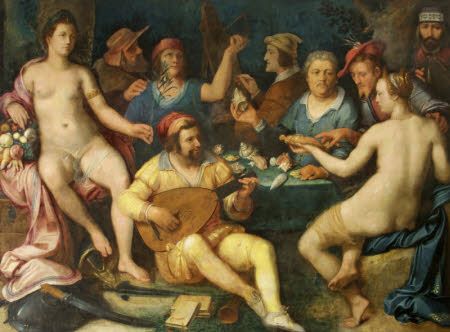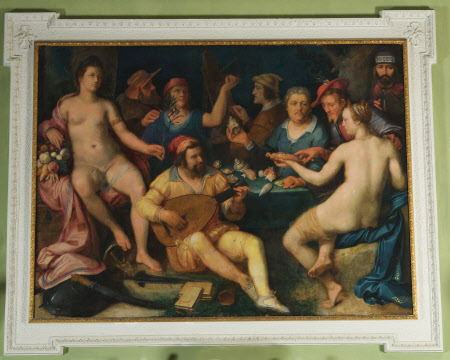Allegory of the Arts and Sciences with a Portrait of Jan Govaertsz. van der Aar (after Cornelis van Haarlem)
Isaac Seeman (fl.1739 – London 1751)
Category
Art / Oil paintings
Date
1746
Materials
Oil on canvas
Measurements
1753 x 2363 mm
Place of origin
England
Order this imageCollection
Lacock, Wiltshire
NT 996268
Caption
This painting shows Jan Govertsz. van der Aar (Leiden 1544/45 – Haarlem 1612), a merchant from Leyden, shown seated at the table, holding a shell, surrounded by personifications of the Arts and Sciences. The original painting at Knole has helped us understand the meaning of the picture. In that painting is an inscription in Hebrew, on a man’s hat, which translates as ‘image of peace’. In the Lacock version, the copyist hasn’t quite managed to transcribe the letters correctly, so the inscription is meaningless. The picture can therefore be understood as an allegory of the flourishing of the arts during times of peace. Peace herself is seated to the left, holding a cornucopia and an olive branch. She rests her foot on a helmet, and beside her are other symbols of conflict. The picture serves to illustrate the sitter’s role as a patron, his taste and learning.
Summary
Oil painting on canvas, Allegory of the Arts and Sciences with a Portrait of Jan Govaertsz. van der Aar, by Isaac Seeman (d.1751), after Cornelis Cornelisz. van Haarlem (Haarlem 1562 - Haarlem 1638), bears CH in monogram and dated (indistinctly) 1607(?). A group of figures seated round a table. At the left a seated female figure with an olive branch in her left hand and a cornucopia of fruit and corn in her right; a sword and books lie on the ground in front; next to her a man dressed in a yellow coat is seated on the ground playing a lute; two figures are behind, an artist at his easel and a man seated at a table on which there are shells and coins; at the right (front plane) a second undraped female is seated, holding a shell which a man in a feathered hat bends over her shoulder to examine; at the extreme right in the background a figure stands facing the spectator, wearing a hat which is inscribed in Hebrew (לשכפד׳כ). The original painting is in the Sackville private collection at Knole and was commissioned by the conchologist Jan Govertsz. van der Aar, whose portrait is included. This version was commissioned by John Ivory Talbot at a cost of £6.0.0 plus £1.10.0 for ‘Lineing & stretching frame’.
Full description
The original painting, held in the Sackville private collection at Knole, provides an insight into the allegorical meaning of this painting. The Knole painting contains a Hebrew inscription on a man’s hat in the top right of the painting, which translates as ‘image of peace’ while in the Lacock version, the comparable inscription is meaningless as the letters were transcribed incorrectly. Horace Walpole (August 28, 1780) described the version at Knole as “Arts and Sciences by Vasari. The Drawing is fine, the colouring good, but there is a great want of harmony”. Considering this inscription, however, the picture can be understood as an allegory of the flourishing of the arts during times of peace. A figure representing Peace is seated to the left, holding a cornucopia and an olive branch. She rests her foot on a helmet, and beside her are other symbols of conflict. The Knole picture illustrates Jan Govaertsz van der Aar's role as a patron, his taste and his learning. John Ivory Talbot likely intended to similarly exalt his role, having also commissioned painting copies such as Venus and Adonis (NT 996272) and Saint Sebastian bound for Martyrdom (NT 996271). According to Pieter J.J. van Thiel, who examined both pictures in quick succession, although the Knole original seems very close, there are several differences: The ornament near the table’s edge in the Knole picture is here replaced by an amorphous spiral shell, and a shell was added between the two next to the lute-player’s shoulder; the string of pearls around the woman’s neck on the left and the astrolabe behind her hand holding the olive branch were omitted; and it can no longer be determined that the artist is painting a female figure on his panel.
Provenance
Bill and receipt (August 28th 1746) from Isaac Seeman, at a cost of £6.0.0 plus £1.10.0 for 'Lineing & stretching frame' (Swindon and Wiltshire History Centre 2664/Box 50/OB18; information given by Elizabeth Gibb); set into the mantelpiece of the Dining Room at Lacock, which was decorated by John Ivory Talbot in the mid-eighteenth century; given by Matilda Theresa Talbot (formerly Gilchrist-Clark) (1871 – 1958), who gave the Abbey, the village of Lacock and the rest of the estate to the National Trust in 1944, along with 96 of the family portraits and other pictures, in 1948.
Credit line
Lacock Abbey, The Talbot Collection (National Trust)
Marks and inscriptions
signed CH (in monogram) [according to Van Thiel, the copyist 'borrowed Cornelis's monogram but did not render it correctly], and an indistinct date of 160 (?)7 [1607 inscribed on the dagger lying in the foreground of the Knole picture].
Makers and roles
Isaac Seeman (fl.1739 – London 1751), artist after Cornelis Cornelisz. van Haarlem (Haarlem 1562 - Haarlem 1638), artist
References
Walpole 1927-1928: Horace Walpole, Journals of Visits to Country Seats, &c., ed. Paget Toynbee, The Volume of the Horace Walpole Society, vol 16, 1927-28, p.77 Vertue 1935-1936: George Vertue, Vertue Note Books: Volume IV, The Volume of the Walpole Society, vol 24, 1935-1936, p.123 van Thiel 1999: Pieter J.J. van Thiel, Cornelis Cornelisz van Haarlem, 1562-1638. A Monograph and Catalogue Raisonné, trans. Diane L. Webb, Doornspijk, 1999, pp.372-3 Webley 2022: John Webley, The Seeman family of artists from Danzig, 2022

